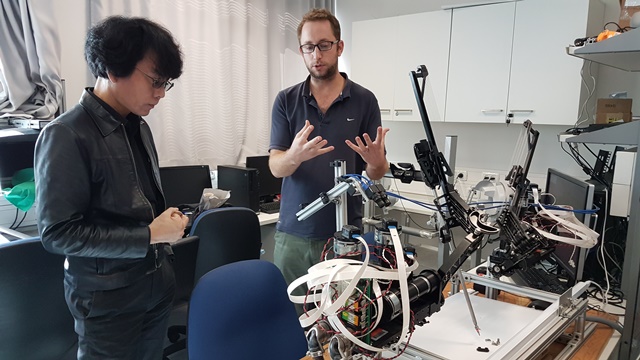
BGU's ABC Robotics Initiative hosted famed Japanese robotics researcher Prof. Hiroshi Ishiguro last week. Ishiguro was in Israel as a guest of the Embassy of Japan to give two lectures in Jerusalem and Tel Aviv and to have work meetings. He came down to Beer-Sheva at the suggestion of the Israeli Robotics Association.
Ishiguro is the director of the Intelligent Robotics Laboratory, in the Department of Systems Innovation in the Graduate School of Engineering Science at Osaka University, Japan. One of the notable developments of the laboratory is the Actroid, a humanoid robot with a lifelike appearance and visible behavior such as facial movements. Ishiguro has made an android that resembles himself called the Geminoid. The Geminoid was among the robots featured by James May in his 5 October 2008 BBC2 documentary on robots “Man-Machine" in his series Big Ideas. Ishiguro has been listed as one of the 15 Asian Scientists To Watch by Asian Scientist Magazine.
He met with an array of BGU researchers to hear about the latest in robotics research, an area in which BGU is especially strong and innovative.
“I saw quite interesting approaches. You also have tight industrial connections so we can work together to develop commercial products quickly. It would be good to do something together," Ishiguro said of his visit to BGU.
Prof. Yael Edan, who heads the ABC Robotics Initiative - Agricultural, Biological and Cognitive established by a special fund from the Leona M. and Harry B. Helmsley Charitable Trust and currently funded by the Marcus Endowment Fund, gave an overview of the initiative. Ishiguro also met with Dr. Ilana Nisky, Dr. David Zarrouk, Prof. Amir Shapiro and Prof. Ronen Brafman as well as Idan Papier from the Center for Digital Innovation at the Advanced Technologies Park adjacent to the University.
In robot development, Ishiguro concentrates on the idea of making a robot that is as similar as possible to a live human being: At the unveiling in July 2005 of the female android Repliee Q1Expo, he was quoted as saying "I have developed many robots before, but I soon realized the importance of its appearance. A human-like appearance gives a robot a strong feeling of presence. Repliee Q1Expo can interact with people. It can respond to people touching it. It's very satisfying, although we obviously have a long way to go yet."
In his opinion, it may be possible to build an android that is indistinguishable from a human, at least during a brief encounter.
Dr. Nisky and Dr. Guy Avraham also challenged him to ensure this robot would also be equipped with a “human-like" handshake - one that feels indistinguishable from a human handshake. Such a motor version of the famous Turing test for artificial intelligence was proposed by the late Prof. Amir Karniel, who believed it to be at least as challenging as the original. Passing it could add a human touch to Repliee Q1Expo and her descendants, Nisky said.
The Turing test for artificial intelligence judged a natural language conversation between a machine and a human being.